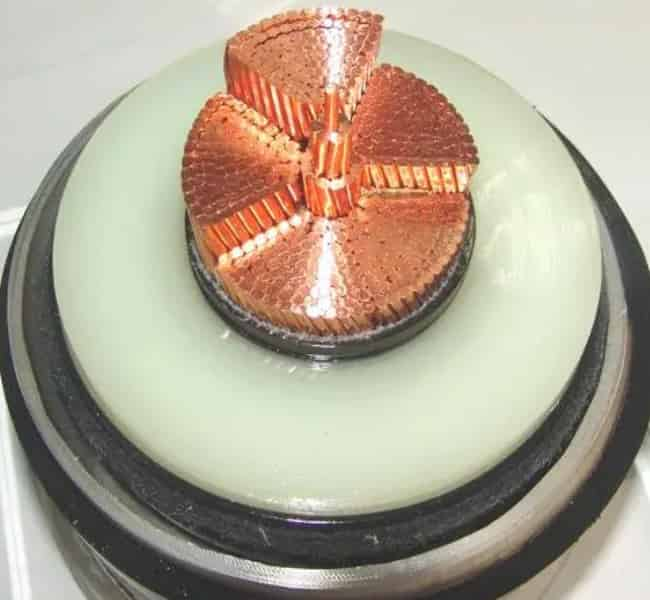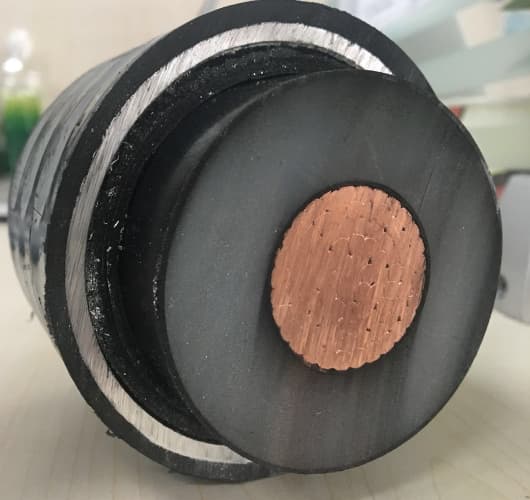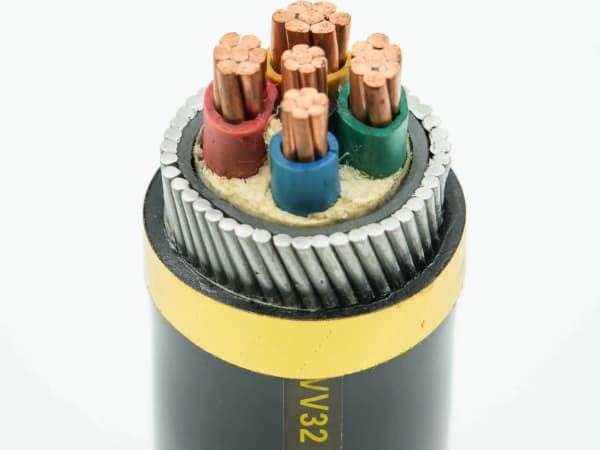এলটি কেবলের মধ্যে পার্থক্য (কম ভোল্টেজ কেবল) এবং এইচটি কেবল (উচ্চ ভোল্টেজ কেবল) বেশ কয়েকটি দিক প্রতিফলিত হয়, ভোল্টেজ স্তর সহ, অ্যাপ্লিকেশন পরিস্থিতি, নকশা মান, উপাদান নির্বাচন, পারফরম্যান্স বৈশিষ্ট্য, এবং সুরক্ষা প্রয়োজনীয়তা. নিম্নলিখিত দুটি ধরণের তারের মধ্যে পার্থক্যের বিশদ বিবরণ দেওয়া হয়েছে:

1. এইচটি কেবল এবং এলটি কেবল ভোল্টেজ রেটিং
এলটি কেবল:
ভোল্টেজ স্তর সাধারণত কম থাকে, সাধারণত 1000V এবং নীচে.
এটি কম ভোল্টেজ সহ বৈদ্যুতিক সিস্টেমগুলির জন্য উপযুক্ত, যা সাধারণত দৈনন্দিন জীবন এবং বাণিজ্যিক জায়গায় ব্যবহৃত হয়, যেমন হোম লাইটিং, অফিস সরঞ্জাম, ছোট বৈদ্যুতিক সরঞ্জাম এবং আরও.
এইচটি কেবল:
ভোল্টেজ স্তরটি এলটি কেবলগুলির চেয়ে বেশি, যা হাজার হাজার ভোল্ট বা এমনকি উচ্চতর পৌঁছাতে পারে.
এটি মূলত শিল্প অ্যাপ্লিকেশনগুলিতে ব্যবহৃত হয় যার জন্য উচ্চ ভোল্টেজ প্রয়োজন, যেমন বৈদ্যুতিক মোটর, ট্রান্সফর্মার, বড় যান্ত্রিক সরঞ্জাম, বিদ্যুৎ কেন্দ্র এবং সাবস্টেশন.
2. এইচটি কেবল এবং এলটি কেবল প্রয়োগের পরিস্থিতি
এলটি কেবল:
দৈনন্দিন জীবন এবং বাণিজ্যিক পরিবেশে ব্যাপকভাবে ব্যবহৃত, যেমন অফিস, শপিংমলস, স্কুল এবং আবাসিক অঞ্চল.
এই জায়গাগুলির বৈদ্যুতিক সিস্টেমে সাধারণত উচ্চ ভোল্টেজের প্রয়োজনীয়তা থাকে না, এবং এলটি কেবলগুলি মৌলিক শক্তি সংক্রমণ প্রয়োজনগুলি পূরণ করতে পারে.
এইচটি কেবল:
প্রধানত শিল্প অঞ্চলে ব্যবহৃত হয়, বিশেষত যাদের উচ্চ ভোল্টেজ বিদ্যুৎ সরবরাহ প্রয়োজন.
এর উচ্চ ভোল্টেজ বৈশিষ্ট্যগুলির কারণে, এইচটি কেবল দীর্ঘ দূরত্বে বিদ্যুৎ সংক্রমণের স্থায়িত্ব এবং দক্ষতা নিশ্চিত করতে পারে.
3.এইচটি কেবল এবং এলটি কেবল ডিজাইনের মান
এলটি কেবল:
ডিজাইনের মান তুলনামূলকভাবে কম, প্রধানত তারের বৈদ্যুতিক পরিবাহিতা উপর ফোকাস করা, নিরোধক এবং সুরক্ষা কর্মক্ষমতা এবং অন্যান্য দিক.
উত্পাদন প্রক্রিয়া তুলনামূলকভাবে সহজ, স্বল্প ব্যয়, ব্যাপক উত্পাদন এবং প্রয়োগের জন্য উপযুক্ত.
এইচটি কেবল:
ডিজাইনের মানগুলি আরও কঠোর, বৈদ্যুতিক পরিবাহিতা ছাড়াও, নিরোধক এবং সুরক্ষা কর্মক্ষমতা, তবে তারের উচ্চ তাপমাত্রা প্রতিরোধের বিষয়টিও বিবেচনা করা দরকার, জারা প্রতিরোধ এবং যান্ত্রিক শক্তি এবং অন্যান্য দিক.
উত্পাদন প্রক্রিয়া আরও জটিল, উচ্চ ভোল্টেজে কেবলটির স্থিতিশীল অপারেশন নিশ্চিত করতে উন্নত উত্পাদন প্রযুক্তি এবং উপকরণগুলির ব্যবহার, উচ্চ লোড শর্ত.
4. এইচটি কেবল এবং এলটি কেবল উপাদান নির্বাচন
এলটি কেবল:
কন্ডাক্টর উপকরণগুলি সাধারণত তামা বা অ্যালুমিনিয়াম এবং ভাল পরিবাহিতা সহ অন্যান্য ধাতু ব্যবহার করে.
নিরোধক উপকরণগুলি বেশিরভাগ পলিভিনাইল ক্লোরাইড (পিভিসি) এবং অন্যান্য সাধারণ অন্তরক উপকরণ, এই উপকরণগুলির ভাল নিরোধক বৈশিষ্ট্য এবং প্রক্রিয়াজাতকরণ কর্মক্ষমতা রয়েছে.
এইচটি কেবল:
কন্ডাক্টর উপকরণগুলি উচ্চ বৈদ্যুতিক পরিবাহিতা সহ তামা বা অ্যালুমিনিয়াম দিয়ে তৈরি হয়, তবে পাওয়ার ট্রান্সমিশনের দক্ষতা এবং গুণমান নিশ্চিত করার জন্য উচ্চতর প্রয়োজনীয়তা সহ.
নিরোধক জন্য, দুর্দান্ত উচ্চ-তাপমাত্রা প্রতিরোধ এবং অন্তরক বৈশিষ্ট্য সহ উপকরণ, যেমন ক্রস লিঙ্কযুক্ত পলিথিন (এক্সএলপিই), ব্যবহৃত হয়. এছাড়াও, এইচটি কেবলগুলি তাদের বিরোধী-হস্তক্ষেপ ক্ষমতা এবং যান্ত্রিক শক্তি উন্নত করতে বিশেষ শিল্ডিং উপকরণ এবং শিথের উপকরণগুলিও ব্যবহার করতে পারে.
5. নকশা প্রয়োজনীয়তা
এলটি কেবল:
কন্ডাক্টর ডিজাইন: এলটি কেবলগুলির কন্ডাক্টর ক্রস-বিভাগীয় অঞ্চলটি কম-ভোল্টেজ সিস্টেমগুলির বর্তমান সংক্রমণ প্রয়োজনীয়তাগুলি পূরণ করতে তুলনামূলকভাবে ছোট.
নিরোধক নকশা: নিরোধক স্তরটির নকশাটি মূলত ভোল্টেজ প্রতিরোধের এবং যান্ত্রিক শক্তি বিবেচনা করে যাতে নিশ্চিত হয় যে সাধারণ ব্যবহারের সময় কেবলটি অতিরিক্ত ভোল্টেজ বা যান্ত্রিক ক্ষতির দ্বারা ক্ষতিগ্রস্থ হবে না.
শীট ডিজাইন: শিথ লেয়ারের নকশাটি মূলত বাহ্যিক পরিবেশ থেকে কেবলটিকে রক্ষা করতে ঘর্ষণ প্রতিরোধ এবং জারা প্রতিরোধের কার্যকারিতা বিবেচনা করে.
এইচটি কেবল:
কন্ডাক্টর ডিজাইন: উচ্চ স্রোত এবং ভোল্টেজ সহ্য করার জন্য এইচটি কেবলগুলির একটি তুলনামূলকভাবে বড় ক্রস-বিভাগীয় অঞ্চল রয়েছে.
নিরোধক নকশা: নিরোধক স্তরটির নকশা আরও জটিল এবং কঠোর, উচ্চ ডাইলেট্রিক শক্তি সহ উপকরণগুলির ব্যবহার এবং নিরোধক কর্মক্ষমতা উন্নত করতে একটি মাল্টি-লেয়ার ইনসুলেশন কাঠামোর বিবেচনার প্রয়োজন. এছাড়াও, উচ্চতর তাপমাত্রায় এখনও ভাল নিরোধক কর্মক্ষমতা বজায় রাখা যায় তা নিশ্চিত করার জন্য অন্তরক উপাদানের তাপ প্রতিরোধের বিষয়টি বিবেচনা করাও প্রয়োজন.
শীট ডিজাইন: শিথ লেয়ারের নকশাকে কেবল ঘর্ষণ এবং জারা প্রতিরোধের কার্যকারিতা বিবেচনা করা উচিত নয়, তবে কেবলটির সুরক্ষা উন্নত করতে আগুন প্রতিরোধ এবং শিখা retardant এর কার্যকারিতা বিবেচনা করা দরকার.
6. এইচটি কেবল এবং এলটি কেবল তার পারফরম্যান্স বৈশিষ্ট্য
এলটি কেবল:
ভাল পরিবাহিতা এবং নিরোধক বৈশিষ্ট্য সহ, এটি দৈনন্দিন জীবন এবং বাণিজ্যিক জায়গাগুলির শক্তি সংক্রমণ প্রয়োজনগুলি পূরণ করতে পারে.
কম খরচ, ইনস্টল এবং বজায় রাখা সহজ.
এইচটি কেবল:
এলটি কেবলের প্রাথমিক পারফরম্যান্স ছাড়াও, এটি উচ্চ তাপমাত্রা প্রতিরোধের দ্বারাও চিহ্নিত করা হয়, জারা প্রতিরোধ এবং উচ্চ যান্ত্রিক শক্তি.
এই বৈশিষ্ট্যগুলি কঠোর শিল্প পরিবেশে এইচটি কেবলগুলি স্থিরভাবে পরিচালনা করতে সক্ষম করে, শক্তি সংক্রমণ সুরক্ষা এবং নির্ভরযোগ্যতা নিশ্চিত করা.
ষষ্ঠ. সুরক্ষা প্রয়োজনীয়তা
এলটি কেবল:
যদিও সুরক্ষার পারফরম্যান্স বেশি, ওভারলোড এড়াতে মনোযোগ দেওয়া এখনও প্রয়োজন, ব্যবহারের প্রক্রিয়াতে শর্ট সার্কিট এবং অন্যান্য সুরক্ষা সমস্যা.
এর স্বাভাবিক অপারেশনটি নিশ্চিত করার জন্য নিয়মিত কেবল এবং যান্ত্রিক শক্তি এবং অন্যান্য সূচকগুলির নিরোধক বৈশিষ্ট্যগুলি পরীক্ষা করা প্রয়োজন.
এইচটি কেবল:
উচ্চ ভোল্টেজ স্তর এবং অ্যাপ্লিকেশন পরিস্থিতিগুলির জটিলতা এবং বৈচিত্র্যের কারণে, এর সুরক্ষার প্রয়োজনীয়তা আরও কঠোর.
ব্যবহারের প্রক্রিয়াতে, তারের নিরাপদ অপারেশন নিশ্চিত করার জন্য প্রাসঙ্গিক সুরক্ষা বিধিমালা এবং অপারেটিং পদ্ধতিগুলি কঠোরভাবে মেনে চলা প্রয়োজন.
ইনস্টলেশন, সম্ভাব্য সুরক্ষার ঝুঁকি রোধে যোগ্য পেশাদারদের দ্বারা কেবলটির রক্ষণাবেক্ষণ এবং ওভারহোলটি করা উচিত.
7. এইচটি কেবল এবং এলটি কেবল সংক্ষিপ্তকরণ
সংক্ষিপ্ত করতে, মধ্যে উল্লেখযোগ্য পার্থক্য আছে এলটি কেবল এবং এইচটি কেবলগুলি ভোল্টেজ স্তরের ক্ষেত্রে, অ্যাপ্লিকেশন পরিস্থিতি, নকশা মান, উপাদান নির্বাচন, কর্মক্ষমতা বৈশিষ্ট্য এবং সুরক্ষা প্রয়োজনীয়তা. এই পার্থক্যগুলি দুটি ধরণের কেবলগুলি তাদের নিজ নিজ ক্ষেত্রে একটি অপরিবর্তনীয় ভূমিকা পালন করে. কেবল নির্বাচন করার সময়, বিদ্যুৎ সংক্রমণের সুরক্ষা এবং নির্ভরযোগ্যতা নিশ্চিত করতে প্রকৃত প্রয়োজন এবং প্রয়োগের পরিবেশ অনুযায়ী উপযুক্ত তারের ধরণটি বেছে নেওয়া প্রয়োজন. একই সময়ে, ব্যবহারের প্রক্রিয়াতে প্রাসঙ্গিক সুরক্ষা বিধিমালা এবং অপারেটিং পদ্ধতিগুলি কঠোরভাবে মেনে চলাও প্রয়োজন, সাধারণ অপারেশন নিশ্চিত করার জন্য এবং তারের পরিষেবা জীবন দীর্ঘায়িত করার জন্য.


